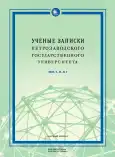NOTES ON THE MEANING OF PRESENT AND AORIST STEMS IN RIG VEDA
- 作者: Krasukhin K.G.1
-
隶属关系:
- Institute of Linguistics of the Russian Academy ofSciences, Lomonosov Moscow State University
- 期: 卷 47, 编号 1 (2025)
- 页面: 59-64
- 栏目: THEORETICAL, APPLIED AND CONTRASTIVE LINGUISTICS
- URL: https://journal-vniispk.ru/2542-1077/article/view/294550
- DOI: https://doi.org/10.15393/uchz.art.2025.1129
- ID: 294550
如何引用文章
全文:
详细
The paper examines the system of aspects and tenses in Rig Veda, focusing particularly on the stemsof the present (both imperfect and injunctive) and the aorist. A complex issue arises in defi ning their meanings andfunctions. The concept of confi ned versus unconfi ned action does not always adequately capture the present-aoristopposition, as present forms can sometimes refer to events that were completed in the past. The author introduces the category of “point of reference”, as articulated by Hans Reichenbach, to clarify this distinction. The aorist tense stands out from other tenses by emphasizing this reference point. Overall, the Vedic verb captures the stage of the evolution of the aspectual system into a temporal one: the imperfect denotes events from a distant mythological past (which maybe completed), while the aorist refers to more recent events or those that precede others. In this sense, the Vedic verb shares similarities with tense forms in European languages, as described by Harald Weinrich, where a contrast is drawn between foreground tenses (French passé simple) and background tenses (French imparfait). This comparison aids in understanding the development of aspect and time categories across different world languages.
关键词
作者简介
K. Krasukhin
Institute of Linguistics of the Russian Academy ofSciences, Lomonosov Moscow State University
编辑信件的主要联系方式.
Email: krasukh@mail.ru
Dr. Sc. (Philology)
参考
- Elizarenkova, T. Ya. Aorist in the Rig Veda. Moscow, 1960. 152 p. (In Russ.)
- Krasukhin, K. G. Movement on the axis of time and verb tense. Questions of Philology, 2000; 4: 13–17. (In Russ.)
- Krasukhin, K. G. Aspects and tenses of the Proto-Indo-European verb: Part I. Topics in the Study of Language, 2005; 6: 3–30. (In Russ.)
- Stepanov, Yu. S. Indo-European sentence. Moscow, 1989. (In Russ.)
- Dahl, E. Time, tense, aspect in Early Vedic grammar: A non-relational approach to the morphosyntax-semantics interface. Oslo, 2008. 460 p.
- Gonda, J. The aspectual functions of the Rgvedic present and aorist. s'Gravenhage, 1962. 286 p.
- Hoffmann, K. Der Injunktiv in Veda. Heidelberg, 1967. 298 S.
- Hollenbaugh, I. Tense and aspect in Indo-European: A usage-based approach to the verbal systems of the Rigveda and Homer: Dissertation. Los Angeles, 2021. 307 p.
- Kiparsky, P. Tense and modes in Indo-European syntax. Foundations of Language. 1968; 4(1): 30–57.
- Kiparsky, P. Aspect and event structure in Vedic. The Yearbook of South Asia languages and linguistics. 1998. P. 29–61.
- Krasuchin, K. Universaltendenzen in der Entwicklung des Aspekt-Tempus-Systems (Aspekt und Zeitdauer). Indogermanistik und Linguistik: Akten der XIII. Fachtagung der Indogermanischen Gesellschaft in Salzburg. Wiesbaden, 2011. S. 289–300.
- Narten, J. Die sigmatische Aoriste in Veda. Wiesbaden, 1963. 311 S.
- Reichenbach, H. Elements of symbolic logic. London, 1947. 444 p.
- Weinrich, H. Tempus: Besprochene und erzählte Welt. Stuttgart, 1964. 358 S.
补充文件








